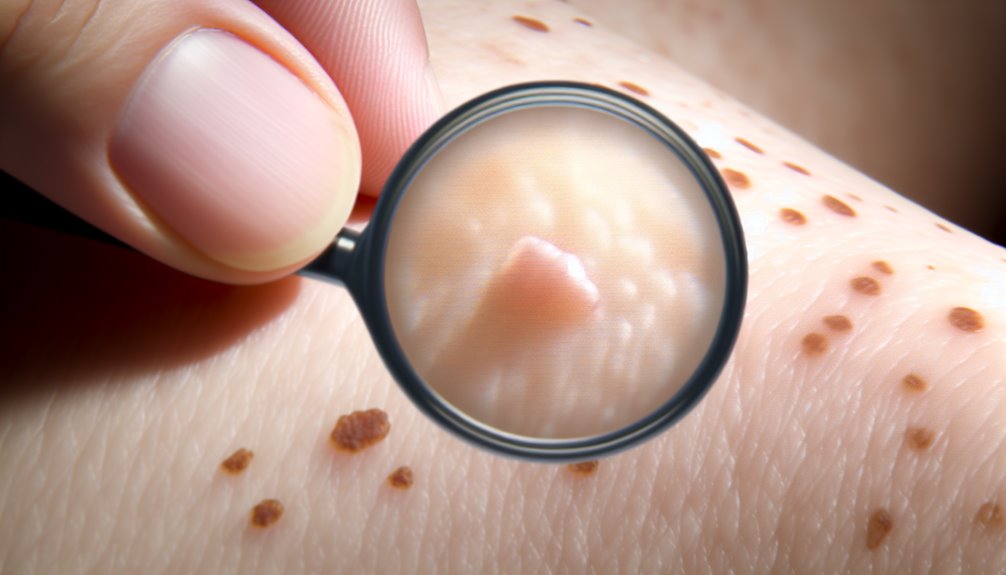If you’re looking for clearer skin, understanding skin tags and their removal is vital. Skin tags are benign growths that can affect your comfort and appearance. Common causes include friction, obesity, and hormonal changes. Effective removal can boost your confidence, and natural remedies like apple cider vinegar and tea tree oil can help. Your skincare routine and lifestyle choices also play significant roles. Discover more about these options and how they can improve your skin’s health and appearance.
Key Points
- Tag Be Gone products offer effective, non-invasive options for removing skin tags, enhancing skin appearance.
- Regular use of natural remedies like apple cider vinegar and tea tree oil can promote skin tag shrinkage.
- Keeping the skin moisturized and wearing loose clothing can help prevent skin tag formation.
- Maintaining a healthy weight and managing hormonal changes can reduce the risk of developing skin tags.
- Following a proper skincare routine and lifestyle changes promotes overall skin health and minimizes skin imperfections.
Understanding Skin Tags: What They Are and Why They Occur

Skin tags, known medically as acrochordons, are small, benign growths that can appear on various parts of the body, particularly in areas where skin rubs together or against clothing. These growths are composed of loose collagen fibers and blood vessels and commonly develop due to friction. Factors such as obesity, hormonal changes, and genetics can also influence their occurrence.
While they’re generally harmless, skin tags can cause discomfort if located in high-friction areas like the neck, armpits, or groin folds. They are most prevalent in adults, with nearly half of the population expected to develop them over time. Although acrochordons aren’t cancerous, any sudden changes in their appearance warrant a consultation with a healthcare professional. For those looking to manage skin tags effectively, products like Tag Be Gone offer gentle and natural methods to promote healthier skin and enhance overall confidence.
Common Causes of Skin Tags
Several key factors contribute to the development of skin tags, primarily involving friction and irritation. These benign growths, also known as acrochordons, often appear in areas where skin rubs against skin or clothing, such as the neck, underarms, eyelids, and groin folds. Common risk factors include obesity, which increases skin-to-skin contact and, consequently, friction. Hormonal changes, especially during pregnancy, can also play a significant role in their formation. Individuals with diabetes are at a higher risk due to elevated blood sugar levels affecting skin integrity. Additionally, a family history of skin tags can predispose you to developing them as genetics often influence susceptibility. By understanding these common causes, you can take proactive steps to minimize friction and irritation, potentially reducing the likelihood of skin tag formation.
Identifying Skin Tags vs. Other Skin Growths

Understanding the characteristics of skin tags is essential for distinguishing them from other skin growths. Skin tags are small, soft, and typically flesh-colored growths that occur in friction-prone areas like the neck and armpits. They have a smooth surface and a stalk-like structure, which makes it easy to identify skin tags. In contrast, warts, caused by viral infections, have a rough texture and irregular shape, while seborrheic keratosis appears scaly and can vary in color.
When considering removal options, you might come across products such as Tag Be Gone. Reviews often highlight its effectiveness in addressing skin tags through its natural ingredients. By understanding the differences in skin tags vs. other skin growths, you can make informed decisions about your skincare routine and whether Tag Be Gone skin products are suitable for your needs.
The Importance of Skin Tag Removal
While many people may overlook skin tags as mere cosmetic nuisances, their removal is often essential for both physical comfort and psychological well-being. These benign growths can cause discomfort, especially in areas prone to friction, like your underarms and neck. Although generally harmless, removing skin tags can enhance your skin’s appearance and boost your self-confidence. You might find that addressing skin tags promptly can prevent irritation from clothing or jewelry, reducing the risk of skin infections from excessive rubbing.
Non-invasive options are increasingly popular, allowing you to avoid the discomfort and scarring associated with professional methods. Many users have shared positive experiences in tag be gone reviews, noting the effectiveness of the product. If you’re looking to eliminate those unwanted skin tags, consider ordering tag be gone or buying tag be gone skin tag for a gentle and efficient solution. Your skin deserves the care it needs for a clearer, more confident appearance.
Natural Remedies for Skin Tag Removal

Have you considered using natural remedies for skin tag removal? Many individuals find success with these gentle methods that promote healthier skin. Here are some effective options you can try:
Explore gentle natural remedies for skin tag removal that promote healthier skin and have been successful for many.
- Apple Cider Vinegar: Its acidic properties may help dry out the skin tag when applied consistently.
- Tea Tree Oil: Known for its antiseptic qualities, this oil can aid in healing when applied directly multiple times a day.
- Garlic: With natural anti-inflammatory and antimicrobial properties, crushed garlic can be applied to skin tags to promote shrinkage over time.
- Banana Peel: The enzymes in banana peel may help break down skin tag tissue; place a piece over the tag overnight.
- Patience is Key: Regular application of these remedies typically takes days to weeks for noticeable results.
Utilizing these natural options can be an effective step toward achieving clearer skin.
Over-the-Counter Treatments for Skin Tags
Natural remedies can effectively address skin tags, but many individuals may also consider over-the-counter treatments for a more immediate solution. These treatments typically include topical creams, serums, and adhesive patches that aim to dissolve or remove skin tags without invasive procedures. Most products contain active ingredients like salicylic acid or natural compounds that target the structure of the skin tag, promoting its gradual elimination.
These over-the-counter options are generally safe for all skin types, ensuring a pain-free experience with minimal risk of irritation or scarring. Users often report visible improvements within 7 to 14 days of consistent application. For maximum effectiveness, it’s essential to follow the application instructions carefully. If you encounter any concerns or complications, consulting a healthcare professional is advisable. This approach allows you to manage skin tags effectively while minimizing discomfort and maintaining skin integrity.
Professional Options for Skin Tag Removal
When you’re considering skin tag removal, professional options offer effective solutions that cater to various needs and preferences. Each method is designed for optimal outcomes and minimal discomfort.
- Cryotherapy: Liquid nitrogen freezes the skin tag, often providing immediate results.
- Surgical excision: A scalpel is used to cut away the tag, ideal for larger or stubborn growths.
- Electrosurgery: High-frequency electrical currents target the tag, minimizing bleeding and allowing precision.
- Laser removal: Focused light beams vaporize skin tags, resulting in less discomfort and quicker healing.
- Follow-up care: Most procedures may require follow-up visits to guarantee complete removal and to address any potential scarring or regrowth.
Consider consulting with a dermatologist to determine which option best suits your needs and to understand the recovery process associated with each method.
Preparing for Skin Tag Removal
After exploring professional options for skin tag removal, it’s important to prepare adequately for the procedure. Start by ensuring the area is clean and dry, as this promotes effective treatment and minimizes the risk of infection. Identify the skin tags you want to remove, noting their size and location; this information can influence your choice of removal method. If you have sensitive skin, consider conducting a patch test on a small area to check for any adverse reactions before proceeding.
Familiarize yourself with the expected timeline for results, as skin tags typically take 7 to 14 days to diminish following treatment. Finally, consult a healthcare professional for personalized advice, especially if the skin tags change in appearance or cause discomfort. Proper preparation sets the foundation for a successful removal process, ultimately leading you to clearer skin and increased confidence.
Aftercare for Skin Tag Removal
To guarantee ideal healing following skin tag removal, it’s essential to keep the treated area clean and dry. This prevents infection and promotes peak recovery. Here are some key aftercare steps to follow:
- Apply a gentle moisturizer to soothe the skin and reduce irritation.
- Avoid direct sunlight exposure to minimize pigmentation changes.
- Refrain from picking or scratching the site to prevent scarring.
- Monitor the area for any unusual redness, swelling, or discharge, which may indicate an infection.
- Follow any specific instructions provided by your healthcare professional for enhanced healing.
Preventing Future Skin Tags
Following proper aftercare is just one part of maintaining your skin’s health. To prevent future skin tags, focus on reducing friction in areas prone to their development. Maintaining a healthy weight can markedly lower the risk, as obesity is a known contributor. Regularly moisturizing high-friction areas will help prevent irritation, which can lead to skin tag formation. Opt for loose-fitting clothing to minimize skin-on-skin contact, further decreasing the likelihood of developing tags in sensitive regions.
Additionally, managing hormonal fluctuations, especially during pregnancy or menopause, may be beneficial, as these changes can influence skin tag occurrence. It’s essential to monitor your skin consistently; early intervention for any changes can prevent skin tags from becoming bothersome. By adopting these preventative measures, you’ll create a proactive approach to your skin health, enhancing your overall confidence and wellbeing.
Skincare Routine for Clearer Skin
A consistent skincare routine can greatly enhance your journey to clearer skin. By incorporating essential practices, you can effectively prevent breakouts and maintain skin health. Here are key steps to follow:
A dedicated skincare routine is vital for achieving clearer skin and preventing breakouts.
- Cleanse Daily: Use a gentle cleanser to remove dirt and excess oil, preventing clogged pores.
- Exfoliate Weekly: Exfoliate 1-2 times a week to eliminate dead skin cells, which can contribute to breakouts.
- Moisturize Wisely: Choose non-comedogenic moisturizers to hydrate your skin without clogging pores.
- Apply Sunscreen: Daily application of sunscreen protects against UV damage that can lead to uneven skin tone.
- Stay Hydrated: Maintain a balanced diet rich in antioxidants, vitamins, and minerals to support skin health from within.
Lifestyle Changes to Promote Healthy Skin
While many factors contribute to skin health, making specific lifestyle changes can greatly enhance your skin’s appearance and resilience. Staying hydrated is essential; drinking adequate water daily supports skin elasticity and helps minimize friction that contributes to skin tag formation. Regular exercise not only aids in weight management but also reduces excess body fat, further decreasing skin friction.
Practicing good hygiene and using gentle, non-irritating skincare products can reduce skin irritation, a known trigger for skin tags. Additionally, limiting sun exposure and consistently applying sunscreen can prevent damage and irritation, maintaining healthier skin overall.
Incorporating a balanced diet rich in antioxidants and vitamins A, C, and E can improve skin health, further reducing the likelihood of developing skin tags. By committing to these lifestyle changes, you’ll promote clearer, healthier skin while enhancing your overall confidence.
The Role of Diet in Skin Health
Diet plays a significant role in maintaining skin health and can directly impact the formation of skin tags. By focusing on nutrient-rich foods, you can enhance your skin’s appearance and resilience. Here are key dietary components to take into account:
- Antioxidants: Include foods rich in vitamins A, C, and E to reduce oxidative stress and promote cellular repair.
- Omega-3 Fatty Acids: Consume fish, flaxseeds, and walnuts to maintain skin elasticity and hydration.
- Hydration: Drink adequate water to support skin hydration and flush out toxins.
- Low-Glycemic Foods: Minimize high-glycemic foods and sugars that can lead to insulin spikes, potentially promoting skin tag development.
- Fruits and Vegetables: Incorporate a variety of these to provide essential nutrients that support overall skin health.
Myths and Misconceptions About Skin Tags
What do you really know about skin tags? It’s important to clarify that skin tags are benign growths and aren’t signs of serious health issues. Many people confuse them with warts or moles, but they’re distinct. Contrary to popular belief, skin tags are not contagious; you can’t catch them from someone else. Another misconception is their association with age—while they’re common in older adults, they can appear at any age, especially in individuals with obesity or diabetes. Additionally, you might think that skin tags must be surgically removed, but many non-invasive treatments can effectively address them. Finally, the fear that skin tags can turn cancerous is unfounded; they’re harmless and don’t have the potential to develop into cancer. Understanding these facts can help alleviate concerns and misconceptions about skin tags, allowing for better management and care.
When to Consult a Dermatologist
Understanding the characteristics of skin tags helps in recognizing when professional advice is necessary. It’s vital to consult a dermatologist under specific circumstances to guarantee your skin health remains a priority. Here are key indicators for a professional evaluation:
- Skin tags that become painful, bleed, or show rapid growth.
- Any changes in color, shape, or texture of the skin tag.
- A personal or family history of skin cancer or significant skin changes.
- Skin tags that irritate due to clothing or jewelry, causing frequent discomfort.
- If you’re considering removal methods beyond home treatments.
Addressing these concerns promptly can prevent complications and guarantee safe, effective treatment tailored to your individual needs. Your skin’s well-being is essential, and a dermatologist can provide the guidance necessary for ideal care.
Boosting Confidence Through Clear Skin
While achieving clear skin may seem like a superficial goal, the impact it has on your confidence and overall well-being is profound. Studies indicate that individuals with fewer visible skin imperfections report higher self-esteem and satisfaction with their appearance. Skin tags and blemishes often lead to self-consciousness, negatively affecting social interactions and personal relationships.
By addressing these skin concerns through effective removal methods, you can greatly enhance your skin’s appearance and boost your self-assurance. Research suggests that those who perceive their skin as clear are more likely to engage positively in personal and professional environments, thereby improving their overall quality of life.
Moreover, maintaining clear skin reflects a commitment to self-care, promoting not just a better appearance but also a sense of well-being and personal pride. Consequently, focusing on achieving clear skin can be an essential step toward enhancing your confidence and enriching your social engagements.
Common Questions
How Long After a Skin Tag Removal Does the Skin Look Good?
After skin tag removal, you can expect noticeable improvements within 7 to 14 days. The skin usually appears clearer and smoother as the tag shrinks and eventually detaches. Most users report minimal to no scarring, especially when utilizing pain-free methods. Complete recovery and enhanced skin texture often occur within a few weeks, provided you maintain proper aftercare, such as keeping the area clean and moisturized to support ideal healing.
Is There a Skin Tag Remover That Really Works?
When it comes to skin tag removers, you’re likely torn between options that promise quick results and those that prioritize safety. The truth is, there are effective solutions. Products like the KUBOZN Pro MicroDarts TAGGone Patch and Natura Pro Skin Tag Remover have shown promising results, delivering noticeable changes without significant discomfort. These methods not only remove skin tags but also support skin health, ensuring you regain confidence in your appearance while minimizing risks.
What Does a Skin Tag Look Like When It Starts?
When a skin tag starts, it often appears as a small, raised bump on your skin, typically flesh-colored or slightly darker. Initially, it may resemble a tiny protrusion that’s soft to the touch. You might notice it in areas where skin rubs against itself or clothing, like the neck or underarms. Over time, it can grow larger and become more noticeable, but it’s usually painless and benign in nature.
What Skin Tag Remover Was on Shark Tank?
The skin tag remover featured on Shark Tank is called “Tag Away.” While some products use invasive methods, Tag Away offers a gentle, non-invasive solution. It utilizes natural ingredients to effectively dry out skin tags, allowing them to eventually fall off. Users have reported varying results—some see improvement within a week, while others may need multiple applications. This approach aims to enhance your skin’s appearance without the discomfort of surgical procedures.
To Sum it Up
In your journey towards clearer skin, remember that the methods you choose can greatly impact your results. As you explore natural remedies and make dietary adjustments, the path to skin tag removal becomes clearer. But what if you discover a growth that doesn’t fit the typical profile? The importance of recognizing when to seek professional help cannot be understated. Don’t let uncertainty hold you back—take the next step towards a more confident you, and watch your skin transform.


